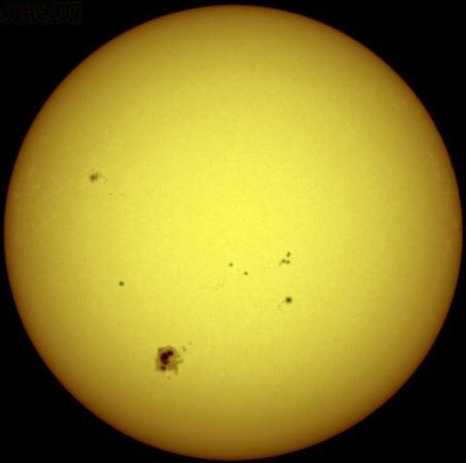First astronomical X-ray source
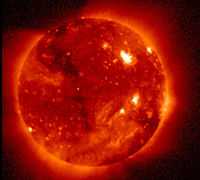
Astronomical X-ray sources surround the Earth from above. These natural X-ray sources irradiate the Earth, but the atmosphere absorbs the X-rays before they reach the surface.
A first astronomical X-ray source is usually considered to be the Sun. The image at right is the first X-ray light image of the Sun by the satellite GOES-15 Solar X-ray Imager (SXI) on June 2, 2010. This learning resource is partially experimental in the sense that it is an exploration of our natural environment here on the Earth's crustal or oceanic surface or somewhere above in or beyond the atmosphere for additional 'first astronomical X-ray sources'. Some of these may have been detected before the Sun. Some irradiate when overhead from apparent point sources.
This is a secondary educational resource because it provides students the opportunity to explore astronomy from the ground up, literally.
As these explorations uncover more complexity in the X-ray sources themselves, the information expands to that often treated in a university undergraduate course. Some of the theoretical concepts, models, and constructs require the advanced knowledge and organization encountered in a graduate level course. Ultimately, to answer such a simple question as, "What is the first X-ray source in the constellation of Andromeda?" requires research. This research may be examination of entries in astronomical databases. It may ultimately require experimentation using an orbiting or exploring X-ray observatory.
With the use of primary sources from the archival literature, this learning resource has information presented along the lines of an article. Some of the information is examined in depth and occasionally to a secondary level for purposes of determining the facts. This need for detail brings the resource into the realm of a lecture or presentation before others for critical examination.
Astronomical X-ray sources by their nature require a working knowledge of several diverse subjects. Each of these is touched on briefly and as needed per X-ray source.
Notations
Notation: let the symbol LLaw: indicate that a logical law is following.
Source astronomy
Probably the first question about astronomy is "Why study astronomy or astronomical sources?"
From a defensive point of view, things occasionally come from the sky and cause some of us, and once in a while all of us, harm. Knowing that it's out there with us in its cross hairs is the first step to stopping or diverting it.
There's also genuine curiosity about the universe around us. "Are we alone in the universe?"
The science of astronomy consists of three fundamental parts:
- physical and logical laws,
- natural entities, and
- the sky.
Def. "the expanse of space that seems to be over the earth like a dome"[1] is called the sky, or sometimes the heavens.
Def. an action or process of throwing or sending out a traveling ray in a line, beam, or stream of small cross section is called radiation.
The term radiation is often used to refer to the ray itself.
Logical laws
Laws or principles are used together with reasoning, logic, and intuition to discern facts and truths which become knowledge to be communicated.
A law or principle that appears as
"A ⊆ B ↔ (∀x) (x ∈ A → x ∈ B)"[2]
conveys little meaning unless the communicatee is familiar with the symbols and context involved.
LLaw: all astronomical sources are astronomical entities, but not all astronomical entities are astronomical sources.
LLaw: all astronomical objects are astronomical entities, but not all astronomical entities are astronomical objects.
X-radiation

X-ray astronomy uses a variety of X-ray detectors often fashioned into X-ray telescopes to detect and observe natural sources that emit, transmit, absorb, reflect, or fluoresce X-rays.
Def. an action or process of throwing or sending out a traveling X-ray in a line, beam, or stream of small cross section is called X-radiation.
Def. a natural source usually of X-rays (X-radiation) in the sky especially at night is called an astronomical X-ray source.
X-rays are electromagnetic radiation from a portion of the wavelength spectrum of about 5 to 8 nanometers (nm)s down to approximately 5 to 8 picometers (pm)s.
Discovery and exploration

Def. "[t]o find something for the first time", from discover, "to obtain sight or knowledge of for the first time"[1] is called discover.
Def. "[s]omething discovered", from discovery, "the act or process of discovering"[1] is called discovery.
Def. "[t]he act of [examining] or [investigating] something systematically", from exploration, "the act or an instance of" "[making] or [conducting] a systematic search",[1] is called exploration.
Discovery usually involves exploration that finds something for the first time, even though it may have already been known yet became lost or uncommunicated (to be rediscovered). Exploration may not find anything.
Intensities

"A super soft X-ray source (SSXS, or SSS) is an astronomical source of very low energy X-rays. Soft X-rays have energies in the 0.09 to 2.5 keV range, whereas hard X-rays are in the 1-20 keV range.[3]"[4]
"SSXSs are in most cases only detected below 0.5 keV, so that within our own galaxy they are usually hidden by interstellar absorption in the galactic disk.[5] They are readily evident in external galaxies, with ~10 found in the Magellanic Clouds and at least 15 seen in M31.[5]"[6]
"Ultraluminous X-ray sources (ULXs) are pointlike, nonnuclear X-ray sources with luminosities above the Eddington limit of 3 × 1039 ergs s−1 for a 20 Mʘ black hole.[7] Many ULXs show strong variability and may be black hole binaries. To fall into the class of intermediate-mass black holes (IMBHs), their luminosities, thermal disk emissions, variation timescales, and surrounding emission-line nebulae must suggest this.[7] However, when the emission is beamed or exceeds the Eddington limit, the ULX may be a stellar-mass black hole.[7] The nearby spiral galaxy NGC 1313 has two compact ULXs, X-1 and X-2. For X-1 the X-ray luminosity increases to a maximum of 3 × 1040 ergs s−1, exceeding the Eddington limit, and enters a steep power-law state at high luminosities more indicative of a stellar-mass black hole, whereas X-2 has the opposite behavior and appears to be in the hard X-ray state of an IMBH.[7]"[8]
The X-ray/optical composite at right "highlights an ultraluminous X-ray source (ULX) shown in the box. ... The timing and regularity of these outbursts ... make the object one of the best candidates yet for a so-called intermediate-mass black hole. ... Chandra X-ray Observatory observations of this ULX have provided evidence that its X-radiation is produced by a disk of hot gas swirling around a black hole with a mass of about 10,000 suns."[9] "Chandra observed M74 twice: once in June 2001 and again in October 2001. The XMM-Newton satellite also (a European Space Agency mission) observed this object in February 2002 and January 2003."[9]
Temporal distributions
"X-ray emission occurs from many celestial objects. These emissions can have a pattern, occur intermittently, or as a transient astronomical event. ... Often, the first X-ray source discovered in many constellations is an X-ray transient. These objects show changing levels of X-ray emission. ... There are a growing number of recurrent X-ray transients."[10]
"[T]he sky is known to be full of transient objects emitting at X- and gamma-ray wavelengths"[11].
Many X-ray sources do not belong to a constellation. Some of these are the Sun and sources apparently in orbit around the Sun. The Sun travels through the 13 constellations along the ecliptic, the 12 of the Zodiac and the constellation Ophiuchus.
Imaged at right is the transient "mystery object" SCP 06F6. "SCP 06F6 is (or was) an astronomical object of unknown type, discovered on February 21, 2006, in the constellation Boötes[12] during a survey of galaxy cluster CL 1432.5+3332.8 with the Hubble Space Telescope's Advanced Camera for Surveys Wide Field Channel.[13]"[10]
"The European X-ray satellite XMM Newton made an observation in early August 2006 which appears to show an X-ray glow around SCP 06F6,[14] two orders of magnitude more luminous than that of supernovae.[15]"[10]
"Most astronomical X-ray transient sources have simple and consistent time structures; typically a rapid brightening followed by gradual fading, as in a nova or supernova."[10]
X-ray bursters
"X-ray bursters are one class of X-ray binary stars exhibiting periodic and rapid increases in luminosity (typically a factor of 10 or greater) peaked in the X-ray regime of the electromagnetic spectrum. ... X-ray bursters differ observationally from other X-ray transient sources (such as X-ray pulsars and soft X-ray transients), showing a sharp rise time (1 – 10 seconds) followed by spectral softening (a property of cooling black bodies). Individual bursts are characterized by an integrated flux of 1039-40 ergs.[16]"[10]
Gamma-ray bursters
"A gamma-ray burst (GRB) is a highly luminous flash of gamma rays ... GRB 970228 was a GRB detected on Feb 28 1997 at 02:58 UTC. Prior to this event, GRBs had only been observed at gamma wavelengths. For several years physicists had expected these bursts to be followed by a longer-lived afterglow at longer wavelengths, such as radio waves, [X-rays], and even visible light. This was the first burst for which such an afterglow was observed.[17]"[10]
"A transient [X-ray] source was detected which faded with a power law slope in the days following the burst. This [X-ray] afterglow was the first GRB afterglow ever detected.[18]"[10]
X-ray pulsars
"For some types of X-ray pulsars, the companion star is a Be star that rotates very rapidly and apparently sheds a disk of gas around its equator. ... SAX J1808.4-3658 is a transient, accreting millisecond X-ray pulsar that is intermittent. In addition, X-ray burst oscillations and quasi-periodic oscillations in addition to coherent X-ray pulsations have been seen from SAX J1808.4-3658, making it a Rosetta stone for interpretation of the timing behavior of low-mass X-ray binaries."[10]
Supergiant Fast X-ray Transients (SFXTs)
SFXTs are "characterized by short outbursts with very fast rise times (~ tens of minutes) and typical durations of a few hours that are associated with OB supergiants and hence define a new class of massive X-ray binaries: Supergiant Fast X-ray Transients (SFXTs).[19] XTE J1739–302 is one of these. Discovered in 1997, remaining active only one day, with an X-ray spectrum well fitted with a thermal bremsstrahlung (temperature of ∼20 keV), resembling the spectral properties of accreting pulsars, it was at first classified as a peculiar Be/X-ray transient with an unusually short outburst.[20] A new burst was observed on Apr 8 2008 with Swift.[20]"[10]
Soft X-rays
Soft X-ray transients (SXT) ... show changing levels of low-energy, or "soft", X-ray emission ... the compact object "gobbles up" the normal star, and the X-ray emission can provide the best view of how this process occurs.[21]"[22]
"Soft X-ray transients Cen X-4 and Aql X-1 were discovered by Hakucho, Japan's first X-ray astronomy satellite to be X-ray bursters.[23]"[22]
"Typical SXTs are usually very faint, or even unobservable, in X-rays and their apparent magnitude in the optical wavelengths is about 20. This is called the "quiescent" state."[22]
"In the "outburst" state the brightness of the system increases by a factor of 100-10000 in both X-rays and optical. During outburst, a bright SXT is the brightest object in the X-ray sky, and the apparent magnitude is about 12. The SXTs have outbursts with intervals of decades or longer, as only a few systems have shown two or more outbursts. The system fades back to quiescence in a few months. During the outburst, the X-ray spectrum is "soft" or dominated by low-energy X-rays, hence the name Soft X-ray transients."[22]
"SXTs are quite rare, about 100 systems are known. SXTs are a class of low-mass X-ray binaries. A typical SXT contains a K-type subgiant or dwarf that is transferring mass to a compact object through an accretion disk."[22]
Spatial distributions
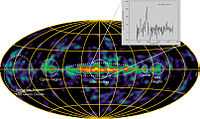
"Aluminium-26, 26Al, is a radioactive isotope of the chemical element aluminium, decaying by either of the modes beta-plus or electron capture, both resulting in the stable nuclide magnesium-26. The half-life of 26Al is 7.17×105 years. This is far too short for the isotope to survive to the present, but a small amount of the nuclide is produced by collisions of argon atoms with cosmic ray protons."[24]
"Aluminium-26 also emits gamma rays and X-rays,[25] and is one of the few radionuclides to emit X-rays."[24]
Backgrounds
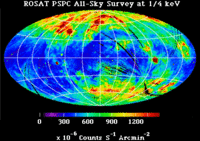
"In addition to discrete sources which stand out against the sky, there is good evidence for a diffuse X-ray background.[26] During more than a decade of observations of X-ray emission from the Sun, evidence of the existence of an isotropic X-ray background flux was obtained in 1956.[27] This background flux is rather consistently observed over a wide range of energies.[26] The early high-energy end of the spectrum for this diffuse X-ray background was obtained by instruments on board Ranger 3 and Ranger 5.[26] The X-ray flux corresponds to a total energy density of about 5 x 10−4 eV/cm3.[26] The ROSAT soft X-ray diffuse background (SXRB) image shows the general increase in intensity from the Galactic plane to the poles. At the lowest energies, 0.1 - 0.3 keV, nearly all of the observed soft X-ray background (SXRB) is thermal emission from ~106 K plasma."[28]
"By comparing the soft X-ray background with the distribution of neutral hydrogen, it is generally agreed that within the Milky Way disk, super soft X-rays are absorbed by this neutral hydrogen."[28]
Constellational X-ray sources
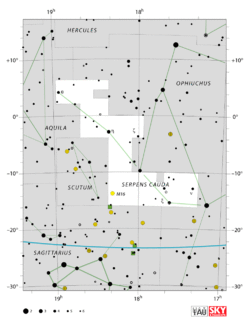
Searching for the first X-ray source per constellation, or such a search, begins as an historical activity in the 1960s as original research, and requires determining the exact boundaries of each constellation.
There are 88 modern constellations that the International Astronomical Union (IAU) has used to divide the celestial sphere into 89 irregularly shaped boxes. The constellation Serpens is split into two separate sections, Serpens Caput (the snake's head) to the west and Serpens Cauda (the snake's tail) to the east.
No publication in print contains the identification of all of the first X-ray sources discovered for each of the 88 (or 89) constellations. In part this apparent lack of completeness is because of
- the discovery of so many X-ray sources in such a short time by X-ray astronomy satellites such as Uhuru (detecting hundreds of X-ray sources with often several per constellation before its deactivation on January 12, 1974), Cosmos 428 and OSO 7, HEAO 1 launched on August 12, 1977, and ROSAT (launched June 1, 1990),
- the discovery of relatively large, somewhat local, X-ray structures such as the Galactic plane and the Large Magellanic Cloud,
- the transient nature of many sources,
- the apparent lack of a coincident source in longer wavelengths of the electromagnetic spectrum such as radio or the visible, in short many X-ray sources are visibly dark X-ray sources,
- alternate naming conventions, and
- the loss of interest in the naming convention as applied to galactic (Milky Way) astronomical X-ray sources; i.e., using the X-# designation.
In addition, a number of interesting events occurred before and while applying the naming convention:
- the first extrasolar X-ray source may have been the diffuse X-ray background,
- the first Aerobee 150 sounding rocket flight that apparently discovered Scorpius X-1[29] may have occurred on June 12[29] or 19th,[30] 1962, and may not have been able to resolve Scorpius X-1 from the Galactic Center as the X-ray detector on board is designed to detect X-rays from the Moon,[31]
- the constellation Serpens is actually divided into Serpens Cauda and Serpens Caput, Serpens X-1 is in Serpens Cauda and Serpens Caput is perhaps ignored,
- the initially chosen Cepheus X-1 is actually in the constellation Cassiopeia,
- some X-ray sources although initially detected as the first X-ray source in a respective constellation may not have received the designation X-1 as they are diffuse sources, contain several X-ray sources within the celestial object, or occupy area in two constellations. The Large Magellanic Cloud (LMC) is in Dorado and Mensa and contains many X-ray sources. Although established as the first X-ray source in Dorado, the LMC is never designated as Dorado X-1. Its first detection is on October 29, 1968,
- an occasional source such as Triangulum Australe X-1 is designated as the X-1 yet another source in the same constellation has been detected earlier and confirmed prior. The same may have happened to Scutum X-1,
- Carina X-1 (Car X-1) may have been a misprint for Cir X-1,
- although Crux X-1 is initially identified on April 4, 1967,[32] it is later realized that Crux X-1 is actually Centaurus X-2,[33]
- no X-ray source is found while scanning the constellation Equuleus by any early satellite including HEAO 1, but the HEAO 1 large area detector picked up an X-ray pulsar from Equuleus on November 18 and 19, 1977.
Spectral distributions
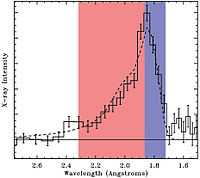
"As of August 27, 2007 discoveries concerning asymmetric iron line broadening and their implications for relativity have been a topic of much excitement. With respect to the asymmetric iron line broadening, Edward Cackett of the University of Michigan commented,"[35]
"We're seeing the gas whipping around just outside the neutron star's surface,". "And since the inner part of the disk obviously can't orbit any closer than the neutron star's surface, these measurements give us a maximum size of the neutron star's diameter. The neutron stars can be no larger than 18 to 20.5 miles across, results that agree with other types of measurements."[36]
"We've seen these asymmetric lines from many black holes, but this is the first confirmation that neutron stars can produce them as well. It shows that the way neutron stars accrete matter is not very different from that of black holes, and it gives us a new tool to probe Einstein's theory", says Tod Strohmayer of NASA's Goddard Space Flight Center.[36]
"This is fundamental physics", says Sudip Bhattacharyya also of NASA's Goddard Space Flight Center in Greenbelt, Maryland and the University of Maryland. "There could be exotic kinds of particles or states of matter, such as quark matter, in the centers of neutron stars, but it's impossible to create them in the lab. The only way to find out is to understand neutron stars."[36]
"Using XMM-Newton, Bhattacharyya and Strohmayer observed Serpens X-1, which contains a neutron star and a stellar companion. Cackett and Jon Miller of the University of Michigan, along with Bhattacharyya and Strohmayer, used Suzaku's superb spectral capabilities to survey Serpens X-1. The Suzaku data confirmed the XMM-Newton result regarding the iron line in Serpens X-1.[36]"[35]
The first three dozen or so astronomical X-ray objects detected other than the Sun "represent a brightness range of about a thousandfold from the most intense source, Sco XR-1, ca. 5 x 10-10 J m-2 s-1, to the weakest sources at a few times 10-13 J m-2 s-1."[37]
Planetary sciences
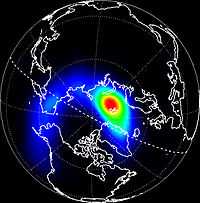
At right is a composite image which contains the first picture of the Earth in X-rays, taken in March, 1996, with the orbiting Polar satellite. The area of brightest X-ray emission is red.
Energetic charged particles from the Sun energize electrons in the Earth's magnetosphere. These electrons move along the Earth's magnetic field and eventually strike the ionosphere, causing the X-ray emission. Lightning strikes or bolts across the sky also emit X-rays.[38]
Theory of first X-ray sources
"In the Crab Nebula X-ray spectrum there are three features that differ greatly from Scorpius X-1: its spectrum is much harder, its source diameter is in light-years (ly)s, not astronomical units (AU), and its radio and optical synchrotron emission are strong.[26] Its overall X-ray luminosity rivals the optical emission and could be that of a nonthermal plasma. However, the Crab Nebula appears as an X-ray source that is a central freely expanding ball of dilute plasma, where the energy content is 100 times the total energy content of the large visible and radio portion, obtained from the unknown source.[26]"[39]
Entities
In 2010: "The X-ray luminosity of the dominant group is an order of magnitude fainter than that of the X-ray jet."[40]
In 2001: "The first class is central-dominant group galaxies, which are very X-ray luminous and may be the focus of group cooling flows."[41]
Sources
"Apart from the Sun, the known X-ray emitters now include planets (Venus, Earth, Mars, Jupiter, and Saturn), planetary satellites (Moon, Io, Europa, and Ganymede), all active comets, the Io plasma torus, the rings of Saturn, the coronae (exospheres) of Earth and Mars, and the heliosphere."[42]
Continua
X-ray continuum emission "can arise both from a jet and from the hot corona of the accretion disc via a scattering process: in both cases it shows a power-law spectrum. In some radio-quiet [active galactic nuclei] AGN there is an excess of soft X-ray emission in addition to the power-law component."[43]
"The X-ray continuum can arise from bremsstrahlung, black-body radiation, synchrotron radiation, or what is called inverse Compton scattering of lower-energy photons by relativistic electrons, knock-on collisions of fast protons with atomic electrons, and atomic recombination, with or without additional electron transitions.[26]"[44]
Emissions
X-ray line emission "is a result of illumination of cold heavy elements by the X-ray continuum that causes fluorescence of X-ray emission lines."[43]
Backgrounds
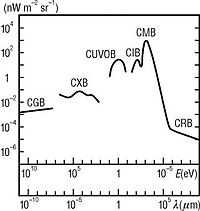
The diffuse cosmic X-ray background is indicated in the figure at right with the notation CXB.
Meteors
"In X-ray wavelengths, many scientists are investigating the scattering of X-rays by interstellar dust, and some have suggested that astronomical X-ray sources would possess diffuse haloes, due to the dust.[45]"[46]
Positrons
"X-ray binaries are a class of binary stars that are luminous in X-rays. The X-rays are produced by matter falling from one component, called the donor (usually a relatively normal star) to the other component, called the accretor, which is compact: a white dwarf, neutron star, or black hole. The infalling matter releases gravitational potential energy, up to several tenths of its rest mass, as X-rays. (Hydrogen fusion releases only about 0.7 percent of rest mass.) An estimated 1041 positrons escape per second from a typical hard low-mass X-ray binary.[47][48]"[49]
Superluminals
"In 1994, a Galactic speed record was obtained with the discovery of a superluminal source in our own Galaxy, the cosmic x-ray source GRS 1915+105. The expansion occurred on a much shorter timescale. Several separate blobs were seen to expand in pairs within weeks by typically 0.5 arcsec.[50] Because of the analogy with quasars, this source was called a microquasar."[51]
Calciums
"The 3.14-3.24 Å [0.314-0.324 nm] region covers emission primarily from Ca XIX (He-like) and Ca XVIII."[52]
Irons
"[I]n the X-ray region where high-temperature emission lines appear during solar flares ... The 1.82-1.97 Å [0.182-0.197 nm] range covers emission from Fe XXV (He-like) and similar transitions in lower degrees of ionization of iron."[52]
Sun
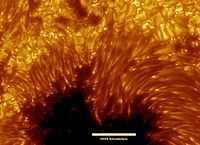
"When we speak of the surface of the Sun, we normally mean the photosphere."[53] "[T]he photosphere may be thought of as the imaginary surface from which the solar light that we see appears to be emitted. The diameter quoted for the Sun usually refers to the diameter of the photosphere."[53]
At right is a visual image of the Sun that shows the ball that is the photosphere, the surface of the Sun. The effective temperature of the photosphere is 5,778 K.[54] This temperature is far too low to emit X-rays.
The "[t]emperature at [the] bottom of [the Sun's] photosphere [is] 6600 K", while the "[t]emperature at [the] top of [the] photosphere [is] 4400 K".[54] The photosphere is "~400 km" thick.[54]
The second image at right is a planet-sized sunspot, a depression in the photosphere that is slightly cooler than the rest of the Sun. The Sun's complex magnetic field creates this cool region by inhibiting hot material from entering the spot. Sunspots can be larger than the Earth. Stereoscopy of a sunspot may show that a sunspot such as the one at right is well over 400 km deep. Ionizing (ultraviolet, X-ray, and gamma-ray) radiation that may originate deep within the Sun does not reach the bottom of a sunspot.
Venus
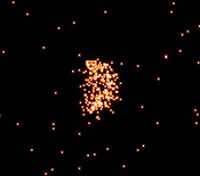
The first ever X-ray image of Venus is shown at right. The "half crescent is due to the relative orientation of the Sun, Earth and Venus. The X-rays from Venus are produced by fluorescent radiation from oxygen and other atoms in the atmosphere between 120 and 140 kilometers above the surface of the planet. In contrast, the optical light from Venus is caused by the reflection from clouds 50 to 70 kilometers above the surface. Solar X-rays bombard the atmosphere of Venus, knock electrons out of the inner parts of atoms, and excite the atoms to a higher energy level. The atoms almost immediately return to their lower energy state with the emission of a fluorescent X-ray. A similar process involving ultraviolet light produces the visible light from fluorescent lamps."[55]
Jupiter
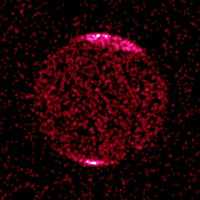
The "image of Jupiter [at right] shows concentrations of auroral X-rays near the north and south magnetic poles."[56] The Chandra X-ray Observatory accumulated X-ray counts from Jupiter for its entire 10-hour rotation on December 18, 2000.
Comets
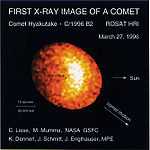
"One of the great surprises of Hyakutake's passage through the inner Solar System was the discovery that it was emitting X-rays [image at left], with observations made using the ROSAT satellite revealing very strong X-ray emission.[57] This was the first time a comet had been seen to do so, but astronomers soon found that almost every comet they looked at was emitting X-rays. The emission from Hyakutake was brightest in a crescent shape surrounding the nucleus with the ends of the crescent pointing away from the Sun."[58]
A 0620-00
"A0620-00, the first x-ray nova to also be visible on an optical telescope (designated V616 Mon), was seen and detected to flare."[59]
Scorpius X-1
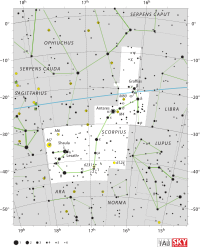
"Scorpius X-1 is an X-ray source located roughly 9000 light years away in the constellation Scorpius. Scorpius X-1 was the first extrasolar X-ray source discovered, and, aside from the Sun, it is the strongest source of X-rays in the sky.[29] The X-ray flux varies day-to-day, and is associated with an optically visible star, V818 Scorpii, that has an apparent magnitude which fluctuates between 12-13.[60] ... As the first discovered X-ray source in Scorpius, it received the designation Scorpius X-1."[61]
"The instrumentation had been designed for an attempt to observe X-rays from the moon and was not equipped with collimation to restrict the field of view narrowly. As a result, the signal was very broad, and accurate definition of the size and position of the source was not possible. A similar experiment was repeated in October 1962 when the galactic center was below the horizon and the strong source was not present. A third attempt, in June 1963, verified the results of the June 1962 flight."[31]
"The Aerobee 150 rocket launched on June 12, 1962, detected the first X-rays from another celestial source (Scorpius X-1) at [B1950] RA 16h 15m Dec -15.2°.[62] [Scorpius X-1] Sco X-1 is a [low-mass X-ray binary] LMXB in which the visual counterpart is V818 Scorpii."[61]
"Although the above reference indicates the rocket launch was on June 12, 1962, other sources indicate the actual launch was at 06:59:00 UTC on June 19, 1962.[30][63]"[61]
Cygnus X-1
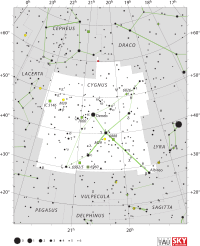
"Cygnus X-1 (abbreviated Cyg X-1)[31] is a well-known black hole and galactic X-ray source[65] in the constellation Cygnus. It was discovered in 1964 during a rocket flight and is one of the strongest X-ray sources seen from Earth, producing a peak X-ray flux density of 2.3×10−23
Wm−2Hz−1 (2.3×103
Jansky).[16][66] Cygnus X-1 was the first X-ray source widely accepted to be a black hole candidate and it remains among the most studied astronomical objects in its class. It is now estimated to have a mass about 14.8 times the mass of the Sun[67] and has been shown to be too compact to be any known kind of normal star or other likely object besides a black hole. If so, the radius of its event horizon is probably about 26 km.[68]"[69]
"Cygnus X-1 belongs to a high-mass X-ray binary system about 6,070 ly from the Sun that includes a blue supergiant variable star designated HDE 226868 which it orbits at about 0.2 AU, or 20% of the distance from the Earth to the Sun. A stellar wind from the star provides material for an accretion disk around the X-ray source.[70] Matter in the inner disk is heated to millions of degrees, generating the observed X-rays.[71][72] A pair of jets, arranged perpendicular to the disk, are carrying part of the infalling material away into interstellar space.[73]"[69]
"Cygnus X-1 was discovered using X-ray instruments that were carried aloft by a sounding rocket launched from White Sands Missile Range in New Mexico. As part of an ongoing effort to map these sources, a survey was conducted in 1964 using two Aerobee suborbital rockets. The rockets carried Geiger counters to measure X-ray emission in wavelength range 1–15 Å across an 8.4° section of the sky. These instruments swept across the sky as the rockets rotated, producing a map of closely spaced scans.[31]"[69]
Cassiopeia X-1
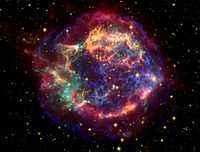
"In 1999, the Chandra X-Ray Observatory found a "hot point-like source" close to the center of the nebula that is quite likely the neutron star or black hole predicted but not previously found.[74][75]"[76]
"Although Cas X-1 (or Cas XR-1), the apparent first X-ray source in the constellation Cassiopeia was not detected during the June 16, 1964, Aerobee sounding rocket flight, it was considered as a possible source.[31] Cas A was scanned during another Aerobee rocket flight of October 1, 1964, but no significant X-ray flux above background was associated with the position.[77] Cas XR-1 was discovered by an Aerobee rocket flight on April 25, 1965,[78] at RA 23h 21m Dec +58° 30′.[79] Cas X-1 is Cas A, a Type II SNR at RA 23h 18m Dec +58° 30′.[80]"[76]
"The designations Cassiopeia X-1, Cas XR-1, Cas X-1 are no longer used, but the X-ray source is Cas A (SNR G111.7-02.1) at 2U 2321+58."[76]
Virgo X-1

In the image at right, "[t]he cluster surrounding M87 is filled with hot gas glowing in X-ray light (and shown in blue) that is detected by Chandra. As this gas cools, it can fall toward the galaxy's centre where it should continue to cool even faster and form new stars."[45]
"However, radio observations with the VLA (red) suggest that in M87 jets of very energetic particles produced by the black hole interrupt this process. These jets lift up the relatively cool gas near the centre of the galaxy and produce shock waves in the galaxy's atmosphere because of their supersonic speed."[45]
"The NRL group launched an Aerobee 150 during April, 1965 that was equipped with a pair of geiger counters.[81] This flight discovered seven candidate X-ray sources, including the first extragalactic X-ray source; designated Virgo X-1 as the first X-ray source detected in Virgo.[82] A later Aerobee rocket launched from White Sands Missile Range on July 7, 1967, yielded further evidence that the source Virgo X-1 was the radio galaxy Messier 87.[83] Subsequent X-ray observations by the HEAO 1 and Einstein Observatory showed a complex source that included the active galactic nucleus of Messier 87.[84] However, there is little central concentration of the X-ray emission.[85]"[86]
Circinus X-1
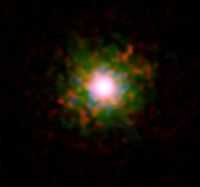
"Circinus X-1 is an X-ray binary star system that includes a neutron star. Observation of Circinus X-1 in July 2007 revealed the presence of X-ray jets normally found in black hole systems; it is the first of the sort to be discovered that displays this similarity to black holes."[87]
"On June 14, 1969, an Aerobee 150 rocket, launched from Natal, Brazil, obtained X-ray data during a scan of the Norma-Lupus-Circinus region that detected a well-isolated source at ℓ = 321.4±0.9° b = -0.5±2° (galactic), RA 15h 14m Dec -57° 49′ within the constellation Circinus and referred to as Circinus XR-1 (Cir XR-1).[88]"[87]
"Low energy X-rays are shown in red, medium energy X-rays in green and high energies in blue. The jet itself is seen to the upper right corner and consists of two fingers of X-ray emission (shown in red) separated by about 30 degrees. These two fingers, located at least about 5 light years from the neutron star, may represent the outer walls of a wide jet. Alternatively, they may represent two separate, highly collimated jets produced at different times by a precessing neutron star. That is, the neutron star may wobble like a top as it spins and the jet fires at different angles at different times. The structures on the opposite side (red, to the lower left) may be evidence for counter jets. The rest of the colored areas surrounding the bright central source are instrumental artifacts and not representative of structures associated with Circinus X-1."[89] "The jet in Circinus X-1 is helping astronomers better understand how neutron stars, and not just black holes, can generate these powerful beams. Many jets have been found originating near black holes (both the supermassive and stellar-mass variety), but the Circinus X-1 jet is the first extended X-ray jet associated with a neutron star in a binary system."[89]
Perseus X-1
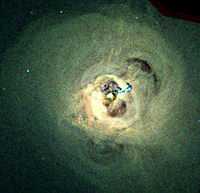
The image at right consists of [w:Chandra X-ray Observatory|Chandra X-ray Observatory]] observations of the central regions of the Perseus galaxy cluster. The image is 284 arcsec across, located at RA 03h 19m 47.60s Dec +41° 30' 37.00" in Perseus. The observation dates from 13 pointings between August 8, 2002 and October 20, 2004.
"The detection of X-ray emission from Per XR-1 occurred during an Aerobee rocket flight on March 1, 1970, the source may be associated with NGC 1275 (Per A, 3C 84), and was reported in 1971.[90] If the source is NGC 1275, Lx ~4 x 1045 ergs/s.[90] More detailed observations from Uhuru confirmed the earlier detection and associated the source with the Perseus cluster.[91] Per X-1 is the galaxy cluster at 4U 0316+41 designated the Perseus Cluster, Abell 426, and NGC 1275."[92]
"The galaxy cluster is the brightest cluster in the sky when observed in the X-ray band.[93]"[92]
"The cluster contains the radio source 3C 84 that is currently blowing bubbles of relativistic plasma into the core of the cluster. These are seen as holes in an X-ray image of the cluster, as they push away the X-ray emitting gas. They are known as radio bubbles, because they appear as emitters of radio waves due to the relativistic particles in the bubble. The galaxy NGC 1275 is located at the centre of the cluster, where the X-ray emission is brightest."[92]
Puppis X-1
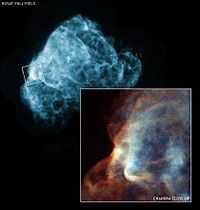
"Puppis X-1 (Puppis A) was discovered by a Skylark flight in October 1971, viewed for 1 min with an accuracy ≥ 2 arcsec,[94] probably at 1M 0821-426, with Puppis A (RA 08h 23m 08.16s Dec -42º 41' 41.40") as the likely visual counterpart. Puppis A is one of the brightest X-ray sources in the X-ray sky. Its X-ray designation is 2U 0821-42."[95]
At right is a composite X-ray image of Puppis A. The Chandra three-color image (inset) is a region of the supernova remnant Puppis A (wide-angle view from ROSAT in blue) which reveals a cloud being torn apart by a shock wave produced in a supernova explosion. The ROSAT image is 88 arcmin across; Chandra image 8 arcmin across. Location for Puppis A is RA 08h 23m 08.16s Dec -42º 41' 41.40". The observation date is September 4, 2005.
First X-ray source in Antlia
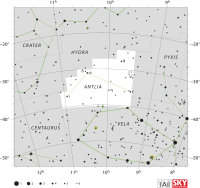
The first X-ray source in Antlia is unknown.
Searching for the first X-ray source per constellation, or such a search, is an historical activity that begins in the 1960s as original research that first requires determining the exact boundaries of each constellation.
There are 88 modern constellations that the International Astronomical Union (IAU) has used to divide the celestial sphere into 89 irregularly shaped boxes. The constellation Serpens is split into two separate sections, Serpens Caput (the snake's head) to the west and Serpens Cauda (the snake's tail) to the east.
Many X-ray sources do not belong to a constellation. Some of these are the Sun and sources apparently in orbit around the Sun. The Sun travels through the 13 constellations along the ecliptic, the 12 of the Zodiac and the constellation Ophiuchus.
Wikipedia
In the Wikipedia article about the constellation Antlia is a list of stars in Antlia.
In the Wikipedia article on the constellation Antlia are a number of key words or abbreviations that can be used to search the SIMBAD database. For example, "NGC 2997, a spiral galaxy, and the Antlia Dwarf Galaxy lie within Antlia's borders."[96] Clicking on the image for NGC 2997 brings up "File:NGC 2997 ESO.jpg.
An easy way to find possible X-ray sources in Antlia is to search Wikipedia using "Antlia" without the quotes and "X-ray" with the quotes. The Antlia Cluster and Delta Antliae are returned, for example.
Under "Notable features" in the Wikipedia article on the constellation Antlia is the brightest star: Alpha Antliae. In the star box of the Wikipedia article alpha Antliae, below the image of the star are coordinates:
- Right ascension: 10h 27m 09.1011s and
- Declination: -31° 04' 04.004".
In the Wikipedia article on Alpha Antliae, use the 'find' command of your browser to see if this Wikipedia page mentions anything about "X-ray", or "X-rays".
What is the current time stamp for the Wikipedia article on Alpha Antliae?
Even though Wikipedia has an article on Alpha Antliae, is it a good place to stop in testing whether Alpha Antliae has been detected as an astronomical X-ray source?
Regarding the Antlia Cluster: "Using the now obsolete scientific satellite ASCA, X-ray observations show the cluster is almost isothermal, with a mean temperature of kT ~ 2.0 keV.[97]"[98] "We observed the Antlia cluster with ASCA on 1997 June 8-9."[97]
"The X-ray properties of the Antlia cluster are peculiar. Pedersen et al. (1997) used ASCA observations centered on NGC 3258, where they clearly found extended X-ray emission. They also noted that the 1.7 keV hot gas extends towards NGC 3268 and they excluded this part from their investigation. The emission peak is offset by 1.1' from NGC 3258 and does not coincide with any other galaxy."[99] and "We obtained a 22,400 s exposure of the NGC 3258 group of galaxies with ASCA in 1994 May."[100]
The Einstein X-ray Observatory satellite "operated for 2 1/2 years beginning in 1978 November [13] ... During its operation, the [Imaging Proportional Counter] IPC obtained nearly 4100 images"[101] which included 1E 1026.7-3521, NGC 3258.
SIMBAD
Provided under 'External links' at the bottom of this page are a number of helpful links. If your browser allows you to view a second window in parallel with this one, click on the external link to the "SIMBAD Astronomical Database".
At the lower right side of the SIMBAD Astronomical Database page is a "Basic search" box. There are several ways to try your target:
- source name: without the quotes use "alpha Antliae", "alpha antliae", or "Alpha Antliae" or
- source coordinates: without the quotes "10 27 09.1011 -31 04 04.004".
The names take you directly to "* alf Ant", but the coordinates yield a list, what's the difference between "* alf Ant" in the table and "Alpha Antliae" on Wikipedia?
If you are looking at the table which lists possible targets, click on the entry "* alf Ant" to look at the entry.
On the page "* alf Ant" read down the left side until you see "Other object types:". To the right of this is a list of other object types that Alpha Antliae is. Look for an X. Is there one in this horizontal list?
Another way to find possible X-ray sources in Antlia is to use other search queries on SIMBAD.
Click on the SIMBAD link under "External links" below, then click on "Criteria query".
In the tan box, type in " cat='NGC' & otype='X' " without the quotes and the spaces after and before these quote marks. This tells the SIMBAD computer you are interested in searching the catalog NGC for X-ray source type objects.
Over at the right from the tan colored box: "Return", the default is "object count". Click on "submit query". In a few moments a result something like "Number of objects: 1387" should appear. Click "Back" to see the tan box again and change "object count" to "display".
SIMBAD will list all these objects with appropriate coordinates that you may compare with the coordinates for Antlia to determine which of these X-ray source objects are in Antlia. I found NGC 3258, NGC 3271, and NGC 3281. Which ones did you find? Other object types that can be searched are 'Sy1' and 'Sy2' combined with otype='X' yield a few more X-ray sources.
Another way to find possible X-ray sources in Antlia is to use other search queries on SIMBAD.
Click on the SIMBAD link under "External links" below, then click on "Criteria query".
In the tan box, type in "region(10 27 09.1011 -31 04 04.004, 10m)", without the quotes. This tells the SIMBAD computer you are interested in a circular region of the celestial sphere centered on the coordinates for alpha Antliae, with a radius of 10 arcminutes (m).
Notice on the page over at the right from the tan colored box: "Return". The default is "object count". Click on "submit query". In a few moments a result something like "Number of objects: 7" should appear. Click "Back" to see the tan box again.
Add "otype='X'" to the entry so that it reads: "region(10 27 09.1011 -31 04 04.004, 10m) & otype='X'", without the outside quotes. Click on "submit query" again. If the result is "0" number of objects, increase the number of arcminutes, or use "1d" which stands for "one degree".
When you find at least one object, change "Return" to "display" by clicking on the circle to its left, then "submit query".
Peruse the SIMBAD page for a time stamp or date of last revision.
Is SIMBAD a 'primary source'?
SIMBAD is an astronomical database provided by the Centre de Données astronomiques de Strasbourg. It is an authoritative source, but they do occasionally make a mistake.
If you find an X-ray source within the constellation on SIMBAD, the next step is to find the earliest time stamp of discovery.
Primary sources
Primary sources may be searched for possible additional information perhaps not yet evaluated by SIMBAD or not presently considered close enough to alpha Antliae to be the star.
Further down the SIMBAD page for "* alf Ant" is a list of "Identifiers (30)". Primary source literature may use any of these to include the star in their experimental observations. From the 'External links' near the bottom of this page, try a search with text something like "alpha antliae" "X-rays" or "X-ray".
Results:
- on Bing with "alpha antliae" and "X-ray" there is "α Ant (Alpha Antliae) - Star - SKY-MAP" which mentions "X-ray sources". A browser search of the page using "x-ray" highlights ten entries below the article title: "Hybrid stars and the reality of "dividing lines" among G to K bright giants and supergiants."[102] Does the article mention "alpha antliae" or "α Ant"? Is the star directly observed as an X-ray source? Do the authors suggest that based on lines observed that alpha Antliae probably is an X-ray source?
delta Antliae (HD 90972, HR 4118) is an X-ray source in Antlia.[103] It has an X-ray luminosity of log Lx = 29.86.[103] It was detected in the same ROSAT all-sky survey during the first half year (1990/91).[104]
NED
Using the coordinates from the Wikipedia article on Epsilon Antliae for this star, a search on NED under 'External links' indicates an X-ray source near the star: "1RXS J092856.0-354610". Test this yourself by clicking on the NASA NED link below. Click on the 'Near position' search. Enter the coordinates for Epsilon Antliae into the longitude block as "09 29 14.7", without the quotes. And, the latitude block as "-35 57 05", without the quotes. Try a radius of 20.0 arcmin, and click on 'search'.
1RXS J092856.0-354610 is an X-ray source.[105] The "all-sky survey [was] performed during the first half year (1990/91) of the ROSAT mission."[105] The abbreviation "1RXS" means "first ROSAT X-ray Source" catalog. The position is 09h 28m 56.0s in right ascension and -35° 46' 10" in declination. Check it out using either the constellation sky chart or the table of coordinates below.
| Right ascension in hours (h) minutes (m) seconds (s) | Declination in degrees |
|---|---|
| 09 27 37.0404 | -24.5425186 |
| 09 27 05.1837 | -37.2920151 |
| 09 26 56.1747 | -40.2918739 |
| 11 05 49.5611 | -40.4246216 |
| 11 05 55.0471 | -35.6746559 |
| 10 55 50.0437 | -35.6664963 |
| 10 55 54.6924 | -31.8332005 |
| 10 40 48.3309 | -31.8185863 |
| 10 40 51.0945 | -29.8186131 |
| 10 20 43.5185 | -29.7947845 |
| 10 20 47.8410 | -27.1281624 |
| 09 50 38.2279 | -27.0835037 |
| 09 50 43.1235 | -24.5835705 |
First X-ray source in Apus
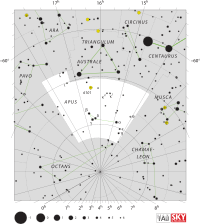
Under "Notable features" in the Wikipedia article on the constellation Apus is the list of stars in Apus. Click on this link. In the table of this Wikipedia article is α Aps. To the right are coordinates:
- Right ascension (RA): 14h 47m 51.73s and
- Declination (Dec): -79° 02' 41.0".
Find these coordinates on the Apus map at the right.
Another Wikipedia source for stars in Apus is the "Template:Stars of Apus", which can be searched by entering "Template:Stars of Apus", without the quotes. Stars already searched may not have had their other designations updated in the template.
The following are some X-ray sources in Apus:
- 1RXS J143729.3-791432 1999 SIMBAD article "1RXS J143729.3-791432"[105] "the all-sky survey [was] performed during the first half year (1990/91) of the ROSAT mission."[105]
- Gamma Apodis (gam Aps on SIMBAD) X-ray source 1RXS J163329.7-785341, "the all-sky survey [was] performed during the first half year (1990/91) of the ROSAT mission."[105] and
- 1RXS J143729.3-791432 2012.01.09CET21:26:56 SIMBAD article "1RXS J143729.3-791432".
Locations on Earth
"[T]he first X-ray surveys of the sky in the Southern Hemisphere" are accomplished by Skylark launches.[106]
History
The beginning of the search for X-ray sources above the Earth's atmosphere is August 5, 1948, at 12:07 GMT (Greenwich Mean Time).[107][108] As part of Project Hermes a US Army (formerly German) V-2 rocket number 43 is launched from White Sands Proving Grounds, launch complex (LC) 33, to an altitude of 166 km.[108] This is "the first detection of solar X-rays."[106]
Exponentials
For some plasma X-ray sources, "an exponential spectrum corresponding to a thermal bremsstrahlung source [may fit]":
where a least squares fit to the X-ray detection data yields a kT.[109]
Catalogs
- "Distribution and Variability of Cosmic X-Ray Sources", published on April 1, 1967, describes 35 astronomical X-ray sources detected by sounding rocket launched with an X-ray detector on board by the X-ray astronomy group at the Naval Research Laboratory in the United States.[110]
Sounding rockets

The first successful attempt to detect X-rays above the Earth's surface occurred at White Sands Proving Grounds on August 5, 1948, by lofting an X-ray detector with a V-2 rocket.
Research
Hypothesis:
- The first at anything can be sufficiently subjective that there is always an earlier first.
Control groups

The findings demonstrate a statistically systematic change from the status quo or the control group.
“In the design of experiments, treatments [or special properties or characteristics] are applied to [or observed in] experimental units in the treatment group(s).[111] In comparative experiments, members of the complementary group, the control group, receive either no treatment or a standard treatment.[112]"[113]
Proof of concept
Def. a “short and/or incomplete realization of a certain method or idea to demonstrate its feasibility"[114] is called a proof of concept.
Def. evidence that demonstrates that a concept is possible is called proof of concept.
The proof-of-concept structure consists of
- background,
- procedures,
- findings, and
- interpretation.[115]
See also
- First astronomical X-ray source/Quiz
- First X-ray source in Andromeda
- First X-ray source in Antlia
- First X-ray source in Apus
- First X-ray source in Aquarius
- Gamma-ray astronomy
- Principles of Radiation Astronomy
- Radiation astronomy
- Serpens X-1
- Source astronomy
- Sun as an X-ray source
- Theoretical astronomy
- Theoretical radiation astronomy
- Ultraviolet astronomy
- X-ray classification of stars
References
- 1 2 3 4 Philip B. Gove, ed (1963). Webster's Seventh New Collegiate Dictionary. Springfield, Massachusetts: G. & C. Merriam Company. pp. 1221.
- ↑ Patrick Suppes (1972). Axiomatic Set Theory. New York: Dover Publications, Inc.. pp. 267. ISBN 0-486-61630-4.
- ↑ "Supersoft X-Ray Sources".
- ↑ "Super soft X-ray source, In: Wikipedia". San Francisco, California: Wikimedia Foundation, Inc. March 8, 2013. Retrieved 2013-05-18.
- 1 2 White NE, Giommi P, Heise J, Angelini L, Fantasia S. "RX J0045.4+4154: A Recurrent Supersoft X-ray Transient in M31". The Astrophysical Journal Letters 445: L125. http://lheawww.gsfc.nasa.gov/users/white/wgacat/apjl.html.
- ↑ Marshallsumter (March 8, 2013). "Super soft X-ray source, In: Wikipedia". San Francisco, California: Wikimedia Foundation, Inc. Retrieved 2013-05-18.
- 1 2 3 4 Feng H, Kaaret P (2006). "Spectral state transitions of the ultraluminous X-RAY sources X-1 and X-2 in NGC 1313". Ap J 650 (1): L75. doi:10.1086/508613.
- ↑ "Astrophysical X-ray source, In: Wikipedia". San Francisco, California: Wikimedia Foundation, Inc. June 12, 2012. Retrieved 2012-06-15.
- 1 2 Jifeng Liu (March 26, 2005). "X-Rays Signal Presence Of Elusive Intermediate-Mass Black Hole". Ann Arbor, Michigan, USA: ScienceDaily. Retrieved 2012-11-25.
- 1 2 3 4 5 6 7 8 9 "X-ray transient, In: Wikipedia". San Francisco, California: Wikimedia Foundation, Inc. April 22, 2012. Retrieved 2013-01-06.
- ↑ Joseph Lazio. "Astronomers Detect Powerful Bursting Radio Source Discovery Points to New Class of Astronomical Objects".
- ↑ "Space 'firefly' resembles no known object". New Scientist News. September 16, 2008. http://space.newscientist.com/article/dn14738-space-firefly-resembles-no-known-object.html.
- ↑ Barbary et al.. "Discovery of an Unusual Optical Transient with the Hubble Space Telescope". Ap J. accepted September 8, 2008. doi:10.1088/0004-637X/690/2/1358.
- ↑ "How they wonder what you are". Nature News. September 19, 2008. doi:10.1038/news.2008.1122. http://www.nature.com/news/2008/080919/full/news.2008.1122.html.
- ↑ Gänsicke et al.; Levan; Marsh; Wheatley (2009). "SCP06F6: A carbon-rich extragalactic transient at redshift z~0.14 Preprint, 2008". The Astrophysical Journal 697 (2): L129–32. doi:10.1088/0004-637X/697/2/L129.
- 1 2 Lewin WHG, van Paradijs J, Taam RE (1993). "X-Ray Bursts". Space Sci Rev. 62 (3–4): 223–389. doi:10.1007/BF00196124.
- ↑ Schilling, Govert (2002). Flash! The hunt for the biggest explosions in the universe. Cambridge: Cambridge University Press. p. 101. ISBN 0-521-80053-6.
- ↑ Costa E et al. (1997). "Discovery of an X-ray afterglow associated with the γ-ray burst of 28 February 1997". Nature 387 (6635): 783–5. doi:10.1038/42885. http://www.nature.com/nature/journal/v387/n6635/full/387783a0.html. Retrieved 2009-04-02.
- ↑ Negueruela I, Smith DM, Reig P, Chaty S, Torrejon JM (2006). "Supergiant Fast X-ray Transients: A new class of high mass X-ray binaries unveiled by INTEGRAL". ESA Spec.Publ. 604 (165).
- 1 2 Sidoli L (2008). Transient outburst mechanisms.
- ↑ Corcoran MF (Oct 2001). "The Fall of Aquila X-1".
- 1 2 3 4 5 "Soft X-ray transient, In: Wikipedia". San Francisco, California: Wikimedia Foundation, Inc. November 18, 2012. Retrieved 2013-01-06.
- ↑ Hayakawa S (1981). "Galactic X-rays observed with X-ray astronomy satellite ‘Hakucho’". Space Sci Rev. 29 (3): 221–90. doi:10.1007/BF00229297. http://www.springerlink.com/content/j945656k0g752788/.
- 1 2 "Aluminium-26, In: Wikipedia". San Francisco, California: Wikimedia Foundation, Inc. March 18, 2013. Retrieved 2013-05-12.
- ↑ "Nuclide Safety Data Sheet Aluminum-26". www.nchps.org.
- 1 2 3 4 5 6 7 Morrison P (1967). "Extrasolar X-ray Sources". Ann Rev Astron Astrophys. 5 (1): 325–50. doi:10.1146/annurev.aa.05.090167.001545.
- ↑ Kupperian JE Jr, Friedman H (1958). "Experiment research US progr. for IGY to 1.7.58". IGY Rocket Report Ser. (1): 201.
- 1 2 "Astrophysical X-ray source, In: Wikipedia". San Francisco, California: Wikimedia Foundation, Inc. November 9, 2012. Retrieved 2012-12-24.
- 1 2 3 Riccardo Giacconi (August 2003). "Nobel Lecture: The dawn of X-ray astronomy". Reviews of Modern Physics 75 (3): 995-1010. doi:10.1103/RevModPhys.75.995.
- 1 2 Stephen A. Drake (based on an original by Jesse S. Allen) (September 11, 2006). "A Brief History of High-Energy Astronomy: 1960 - 1964". Goddard Space Flight Center, Greenbelt, Maryland: National Aeronautics and Space Administration. Retrieved 2012-01-01.
- 1 2 3 4 5 S. Bowyer, E. T. Byram, T. A. Chubb and H. Friedman (1965). Jean-Louis Steinberg. ed. Observational results of X-ray astronomy, In: Astronomical Observations from Space Vehicles. Proceedings from Symposium no. 23 held in Liege, Belgium, 17 to 20 August 1964: International Astronomical Union. pp. 227-39. http://adsabs.harvard.edu/cgi-bin/nph-data_query?bibcode=1965IAUS...23..227B&link_type=ARTICLE&db_key=AST&high=4ebb0ab57b11987. Retrieved 2012-01-01.
- ↑ J. R. Harries, K. G. McCracken, R. J. Francey & A. G. Fenton (July 1967). "A Strong X-ray Source in the Vicinity of the Constellation Crux". Nature 215 (5096): 38-40. doi:10.1038/215038b0.
- ↑ B. A. Cooke, K. A. Pounds, E. A. Stewardson, and D. J. Adams (December 1967). "A Cosmic X-Ray Survey in the Southern Hemisphere". The Astrophysical Journal 150 (12): L189-91. doi:10.1086/180122.
- ↑ "File:187900main colorpress1 lg.jpg". Wikimedia Commons (San Francisco, California: Wikimedia Foundation, Inc). November 4, 2012. http://commons.wikimedia.org/wiki/File:187900main_colorpress1_lg.jpg. Retrieved 2012-07-17.
- 1 2 "History of X-ray astronomy, In: Wikipedia". San Francisco, California: Wikimedia Foundation, Inc. June 24, 2012. Retrieved 2012-07-17.
- 1 2 3 4 Gibb M,Bhattacharyya S, Strohmayer T, Cackett E, Miller J. "Astronomers Pioneer New Method for Probing Exotic Matter".
- ↑ Friedman H (November 1969). "Cosmic X-ray observations". Proceedings of the Royal Society of London. Series A, Mathematical and Physical Sciences 313 (1514): 301-15. http://www.jstor.org/pss/2416439. Retrieved 2011-11-25.
- ↑ Newitz, A. (2007) Educated Destruction 101. Popular Science magazine, September. pg. 61.
- ↑ Marshallsumter (April 15, 2013). "X-ray astronomy, In: Wikipedia". San Francisco, California: Wikimedia Foundation, Inc. Retrieved 2013-05-11.
- ↑ A. Finoguenov, M.G. Watson, M. Tanaka, C.Simpson, M. Cirasuolo, J.S. Dunlop, J.A. Peacock, D. Farrah, M. Akiyama, Y. Ueda, V. Smolčič, G. Stewart, S. Rawlings, C.vanBreukelen, O. Almaini, L.Clewley, D.G. Bonfield, M.J. Jarvis, J.M. Barr, S. Foucaud, R.J. McLure, K. Sekiguchi, E. Egami (April 2010). "X-ray groups and clusters of galaxies in the Subaru-XMM Deep Field". Monthly Notices of the Royal Astronomical Society 403 (4): 2063-76. doi:10.1111/j.1365-2966.2010.16256.x. http://onlinelibrary.wiley.com/doi/10.1111/j.1365-2966.2010.16256.x/full. Retrieved 2011-12-09.
- ↑ SF Helsdon, TJ Ponman, E O'Sullivan (August 2001). "X‐ray luminosities of galaxies in groups". Monthly Notices of the Royal Astronomical Society 325 (2): 693-706. http://onlinelibrary.wiley.com/doi/10.1046/j.1365-8711.2001.04490.x/full. Retrieved 2014-01-16.
- ↑ Anil Bhardwaj, Ronald F. Elsner, G. Randall Gladstone, Thomas E. Cravens, Carey M. Lisse, Konrad Dennerl, Graziella Branduardi-Raymont, Bradford J. Wargelin, J. Hunter Waite Jr., Ina Robertson, Nikolai Østgaard, Peter Beiersdorfer, Steven L. Snowden, Vasili Kharchenko (June 2007). "X-rays from solar system objects". Planetary and Space Science 55 (9): 1135-89. doi:10.1016/j.pss.2006.11.009. http://web.ift.uib.no/~nikost/papers/Solar_System_X-rays_PSS_review_revised_paper.pdf. Retrieved 2013-05-23.
- 1 2 "Active galactic nucleus, In: Wikipedia". San Francisco, California: Wikimedia Foundation, Inc. April 29, 2013. Retrieved 2013-05-06.
- ↑ "X-ray astronomy, In: Wikipedia". San Francisco, California: Wikimedia Foundation, Inc. April 15, 2013. Retrieved 2013-05-10.
- 1 2 3 Smith RK, Edgar RJ, Shafer RA (Dec 2002). "The X-ray halo of GX 13+1". Ap J 581 (1): 562–69. doi:10.1086/344151. http://iopscience.iop.org/0004-637X/581/1/562.
- ↑ "Cosmic dust, In: Wikipedia". San Francisco, California: Wikimedia Foundation, Inc. April 27, 2013. Retrieved 2013-05-12.
- ↑ Georg Weidenspointner (January 8, 2008). "An asymmetric distribution of positrons in the Galactic disk revealed by gamma-rays". Nature 451 (7175). doi:10.1038/nature06490. http://www.nature.com/nature/journal/v451/n7175/abs/nature06490.html. Retrieved 2009-05-04.
- ↑ "Mystery of Antimatter Source Solved – Maybe" by John Borland 2008
- ↑ "X-ray binary, In: Wikipedia". San Francisco, California: Wikimedia Foundation, Inc. March 12, 2013. Retrieved 2013-05-12.
- ↑ I.F. Mirabel, L.F. Rodriguez (1994). "A superluminal source in the Galaxy". Nature 371 (6492): 46–8. doi:10.1038/371046a0.
- ↑ "Superluminal motion, In: Wikipedia". San Francisco, California: Wikimedia Foundation, Inc. April 22, 2013. Retrieved 2013-05-12.
- 1 2 G. A. Doschek, U. Feldman, and R. W. Kreplin and Leonard Cohen (July 15, 1980). "High-resolution X-ray spectra of solar flares. III - General spectral properties of X1-X5 type flares". The Astrophysical Journal 239 (07): 725-37. doi:10.1086/158158.
- 1 2 Mike Guidry (1999-04-16). "The Photosphere of the Sun". University of Tennessee. Retrieved 2006-10-12.
- 1 2 3 David R. Williams (September 2004). "Sun Fact Sheet". Greenbelt, MD: NASA Goddard Space Flight Center. Retrieved 2011-12-20.
- ↑ K. Dennerl (November 29, 2001). "Venus: Venus in a New Light". Boston, Massachusetts, USA: Harvard University, NASA. Retrieved 2012-11-26.
- ↑ NASA/CXC/SWRI/G.R.Gladstone et al. (February 27, 2002). "Jupiter Hot Spot Makes Trouble For Theory". Cambridge, Massachusetts: Harvard-Smithsonian Center for Astrophysics. Retrieved 2012-07-11.
- ↑ J Glanz (1996). "Comet Hyakutake Blazes in X-rays". Science 272 (5259): 194–0. doi:10.1126/science.272.5259.194.
- ↑ "Comet Hyakutake, In: Wikipedia". San Francisco, California: Wikimedia Foundation, Inc. March 12, 2013. Retrieved 2013-05-21.
- ↑ "August 1975, In: Wikipedia". San Francisco, California: Wikimedia Foundation, Inc. March 27, 2013. Retrieved 2013-05-12.
- ↑ Iosif S. Shklovskii (1978). Stars: Their Birth, Life, and Death. W.H. Freeman. ISBN 978-0-7167-0024-1. http://books.google.com/?id=exSFQgAACAAJ.
- 1 2 3 "Scorpius X-1, In: Wikipedia". San Francisco, California: Wikimedia Foundation, Inc. May 6, 2012. Retrieved 2013-01-06.
- ↑ Giacconi R (August 2003). "Nobel Lecture: The dawn of X-ray astronomy". Review of Modern Physics 75 (3): 995–1010. doi:10.1103/RevModPhys.75.995.
- ↑ "Chronology - Quarter 2 1962".
- 1 2 Bernard Abrams, Michael Stecker (1999). Structures in Space: Hidden Secrets of the Deep Sky. Springer. pp. 91. ISBN 1-85233-165-8.
- ↑ Staff (2004-11-05). "Observations: Seeing in X-ray wavelengths". ESA. Retrieved 2008-08-12.
- ↑ 2010 X-Ray Sources, In: The Astronomical Almanac. U.S. Naval Observatory. http://asa.usno.navy.mil/SecH/Xray.html. Retrieved 2009-08-04. gives a range of 235–1,320 μJy at energies of 2–10 kEv, where a Jansky (Jy) is 10−26
Wm-2 Hz-1. - ↑ Jerome Orosz (December 1, 2011). The Mass of the Black Hole In Cygnux X-1. http://iopscience.iop.org/0004-637X/742/2/84. Retrieved 2012-03-24.
- ↑ T. Harko (June 28, 2006). "Black Holes". University of Hong Kong. Retrieved 2008-03-28.
- 1 2 3 "Cygnus X-1, In: Wikipedia". San Francisco, California: Wikimedia Foundation, Inc. December 27, 2012. Retrieved 2013-01-06.
- ↑ D. R. Gies, C. T. Bolton (1986). "The optical spectrum of HDE 226868 = Cygnus X-1. II — Spectrophotometry and mass estimates". The Astrophysical Journal, Part 1 304: 371–93. doi:10.1086/164171.
- ↑ Sergei Nayakshin, James B. Dove (November 3, 1998). "X-rays From Magnetic Flares In Cygnus X-1: The Role Of A Transition Layer". arXiv:astro-ph/11059. Bibcode:1998astro.ph.11059N.
- ↑ A. J. Young, A. C. Fabian, R. R. Ross, Y. Tanaka (2001). "A Complete Relativistic Ionized Accretion Disc in Cygnus X-1". Monthly Notices of the Royal Astronomical Society 325 (3): 1045–52. doi:10.1046/j.1365-8711.2001.04498.x.
- ↑ Elena Gallo, Rob Fender (2005). "Accretion modes and jet production in black hole X-ray binaries". Memorie della Società Astronomica Italiana 76: 600–7.
- ↑ Pavlov GG, Zavlin VE, Aschenbach B, Trumper J, Sanwal D (2000). "The Compact Central Object in Cassiopeia A: A Neutron Star with Hot Polar Caps or a Black Hole?". The Astrophysical Journal 531 (1): L53–6. doi:10.1086/312521. PMID 10673413.
- ↑ Celebrating 5 Years with Chandra: Cassiopeia A
- 1 2 3 "Cassiopeia A, In: Wikipedia". San Francisco, California: Wikimedia Foundation, Inc. December 6, 2012. Retrieved 2013-01-07.
- ↑ Fisher PC, Johnson HM, Jordan WC, Meyerott AJ, Acton LW (1966). "Observations of Cosmic X-rays". The Astrophysical Journal 143: 203–17. doi:10.1086/148491.
- ↑ Byram ET, Chubb TA, Friedman H (April 1966). "Cosmic X-ray Sources, Galactic and Extragalactic". Science 152 (3718): 66–71. doi:10.1126/science.152.3718.66. PMID 17830233. http://www.sciencemag.org/cgi/content/abstract/152/3718/66.
- ↑ Friedman H, Byram ET, Chubb TA (April 1967). "Distribution and Variability of Cosmic X-Ray Sources". Science 156 (3773): 374–8. doi:10.1126/science.156.3773.374. PMID 17812381. http://www.sciencemag.org/cgi/content/abstract/156/3773/374.
- ↑ Webber WR (December 1968). "X-ray astronomy-1968 vintage". Proc Astron Soc Australia.: 160–4.
- ↑ Stephen A. Drake. "A Brief History of High-Energy Astronomy: 1965 - 1969". NASA HEASARC. Retrieved 2011-10-28.
- ↑ Charles, P. A.; Seward, F. D. (1995). Exploring the X-ray universe. Cambridge, England: Press Syndicate of the University of Cambridge. p. 9. ISBN 0-521-43712-1.
- ↑ Bradt, H.; Naranan, S.; Rappaport, S.; Spada, G. (June 1968). "Celestial Positions of X-Ray Sources in Sagittarius". The Astrophysical Journal 152 (6): 1005–13. doi:10.1086/149613.
- ↑ Lea, S. M.; Mushotzky, R.; Holt, S. S. (November 1982). "Einstein Observatory solid state spectrometer observations of M87 and the Virgo cluster". The Astrophysical Journal 262: 24–32. doi:10.1086/160392.
- ↑ B. D. Turland (February 1975). "Observations of M87 at 5 GHz with the 5-km telescope". Monthly Notices of the Royal Astronomical Society 170: 281–94.
- ↑ "Messier 87, In: Wikipedia". San Francisco, California: Wikimedia Foundation, Inc. December 24, 2012. Retrieved 2013-01-07.
- 1 2 "Circinus X-1, In: Wikipedia". San Francisco, California: Wikimedia Foundation, Inc. October 5, 2012. Retrieved 2013-01-06.
- ↑ Margon B, Lampton M, Bowyer S, Cruddace R (October 1971). "A Pulsing X-Ray Source in Circinus". The Astrophysical Journal 169 (10): L23–5. doi:10.1086/180806.
- 1 2 S. Heintz et al. (February 13, 2009). "Circinus X-1: Neutron Stars Join The Black Hole Jet Set". 60 Garden Street, Cambridge, MA 02138 USA: NASA/CXC/Univ. of Wisconsin-Madison, Harvard-Smithsonian Center for Astrophysics. Retrieved 2013-01-06.
- 1 2 Fritz G, Davidsen A, Meekins JF, Friedman H (March 1971). "Discovery of an X-ray source in Perseus". The Astrophysical Journal 164 (3): L81–5. doi:10.1086/180697.
- ↑ Forman, et al. (1972).
- 1 2 3 "Perseus Cluster, In: Wikipedia". San Francisco, California: Wikimedia Foundation, Inc. October 19, 2012. Retrieved 2013-01-07.
- ↑ Edge AC, Stewart GC, Fabian AC (1992). "Properties of cooling flows in a flux limited sample of clusters of galaxies". MNRAS 258: 177.
- ↑ Wiggin M (December 2000). "The Dome on Ball Hill – The RAE Observatory" (PDF).
- ↑ "Puppis A, In: Wikipedia". San Francisco, California: Wikimedia Foundation, Inc. July 30, 2012. Retrieved 2013-01-07.
- ↑ "Antlia, In: Wikipedia". San Francisco, California: Wikimedia Foundation, Inc. February 24, 2013. Retrieved 2013-03-13.
- 1 2 Kazuhiro Nakazawa, Kazuo Makishima, Yasushi Fukazawa, Takayuki Tamura (August 2000). "ASCA Observations of a Near-by Cluster in Antlia". Publications of the Astronomical Society of Japan (Tokyo, Japan: PASJ) 52: 623–630. http://adsabs.harvard.edu/abs/2000PASJ...52..623N. Retrieved March 4, 2012.
- ↑ "Antlia Cluster, In: Wikipedia". San Francisco, California: Wikimedia Foundation, Inc. February 27, 2013. Retrieved 2013-03-11.
- ↑ B. Dirsch - T. Richtler - L. P. Bassino (September IV 2003). "The globular cluster systems of NGC 3258 and NGC 3268 in the Antlia cluster". Astronomy & Astrophysics 408 (3): 929-39. doi:10.1051/0004-6361:20031027. http://www.aanda.org/index.php?option=com_article&access=standard&Itemid=129&url=/articles/aa/full/2003/36/aah4465/aah4465.html. Retrieved 2013-03-13.
- ↑ Kristian Pedersen, Yuzuru Yoshii and Jesper Sohher-Larsen (August 10 1997). "A New Measurement of the Baryonic Fraction Using the Sparse NGC 3258 Group of Galaxies". The Astrophysical Journal 485 (1): L17-20. http://adsabs.harvard.edu/abs/1997ApJ...485L..17P. Retrieved 2013-03-13.
- ↑ Aaron D. Lewis, John T. Stocke, and E. Ellingson and Eric J. Gaidos (February 20, 2002). "New X-Ray Clusters in the Einstein Extended Medium-Sensitivity Survey. I. Modifications to the X-Ray Luminosity Function". The Astrophysical Journal 566 (2): 744-70. http://iopscience.iop.org/0004-637X/566/2/744/fulltext/. Retrieved 2013-03-13.
- ↑ D. Reimers, M. Hünsch, J.H.M.M. Schmitt, and F. Toussaint (June 1996). "Hybrid stars and the reality of "dividing lines" among G to K bright giants and supergiants". Astronomy and Astrophysics 310 (6): 813-24.
- 1 2 S. Hubrig, D. LeMignant, P. North, and J. Krautter (June 2001). "Search for low-mass PMS companions around X-ray selected late B stars". Astronomy and Astrophysics 372 (6): 152-64. doi:10.1051/0004-6361:20010452. http://arxiv.org/pdf/astro-ph/0103201v1. Retrieved 2012-05-30.
- ↑ T.W. Berghöfer, J.H.M.M. Schmitt and J.P. Cassinelli (September 1996). "The ROSAT all-sky survey catalogue of optically bright OB-type stars". Astronomy and Astrophysics Supplement Series 118 (9): 481-94. http://www.aanda.org/index.php?option=com_article&access=bibcode&Itemid=129&bibcode=2001A%2526A...372..152HFUL. Retrieved 2012-05-30.
- 1 2 3 4 5 W. Voges, B. Aschenbach, Th. Boller, H. Bräuninger, U. Briel, W. Burkert, K. Dennerl, J. Englhauser, R. Gruber, F. Haberl, G. Hartner, G. Hasinger, M. Kürster, E. Pfeffermann, W. Pietsch, P. Predehl, C. Rosso, J.H.M.M. Schmitt, J. Trümper, and H.U. Zimmermann (September 1999). "The ROSAT all-sky survey bright source catalogue". Astronomy and Astrophysics 349 (9): 389-405.
- 1 2 Ken Pounds (September 2002). "Forty years on from Aerobee 150: a personal perspective". Philosophical Transactions of the Royal Society London A 360 (1798): 1905-21. doi:10.1098/rsta.2002.1044. PMID 12804236. http://rsta.royalsocietypublishing.org/content/360/1798/1905.long. Retrieved 2011-10-19.
- ↑ Rolf Mewe (December 1996). "X-ray Spectroscopy of Stellar Coronae: History - Present - Future". Solar Physics 169 (2): 335-48. doi:10.1007/BF00190610.
- 1 2 T. R. Burnight (1949). "Soft X-radiation in the upper atmosphere". Physical Review A 76: 165.
- ↑ R. M. Thomas (December 1968). "The Detection of High-Energy X-rays from Ara XR-1 and Nor XR-1". Proceedings of the Astronomical Society of Australia 1 (12): 156-6.
- ↑ Friedman H, Byram ET, Chubb TA (April 1967). "Distribution and Variability of Cosmic X-Ray Sources". Science 156 (3773): 374-8. doi:10.1126/science.156.3773.374. PMID 17812381.
- ↑ Klaus Hinkelmann, Oscar Kempthorne (2008). Design and Analysis of Experiments, Volume I: Introduction to Experimental Design (2nd ed.). Wiley. ISBN 978-0-471-72756-9. http://books.google.com/?id=T3wWj2kVYZgC&printsec=frontcover.
- ↑ R. A. Bailey (2008). Design of comparative experiments. Cambridge University Press. ISBN 978-0-521-68357-9. http://www.cambridge.org/uk/catalogue/catalogue.asp?isbn=9780521683579.
- ↑ "Treatment and control groups, In: Wikipedia". San Francisco, California: Wikimedia Foundation, Inc. May 18, 2012. Retrieved 2012-05-31.
- ↑ "proof of concept, In: Wiktionary". San Francisco, California: Wikimedia Foundation, Inc. November 10, 2012. Retrieved 2013-01-13.
- ↑ Ginger Lehrman and Ian B Hogue, Sarah Palmer, Cheryl Jennings, Celsa A Spina, Ann Wiegand, Alan L Landay, Robert W Coombs, Douglas D Richman, John W Mellors, John M Coffin, Ronald J Bosch, David M Margolis (August 13, 2005). "Depletion of latent HIV-1 infection in vivo: a proof-of-concept study". Lancet 366 (9485): 549-55. doi:10.1016/S0140-6736(05)67098-5. http://www.ncbi.nlm.nih.gov/pmc/articles/PMC1894952/. Retrieved 2012-05-09.
Further reading
- Manuel Güdel (September 2004). "X-ray astronomy of stellar coronae". The Astronomy and Astrophysics Review 12 (2-3): 71–237. doi:10.1007/s00159-004-0023-2.
External links
- African Journals Online
- Bing Advanced search
- Google Books
- Google scholar Advanced Scholar Search
- International Astronomical Union
- JSTOR
- Lycos search
- NASA/IPAC Extragalactic Database - NED
- NASA's National Space Science Data Center.
- NCBI All Databases Search
- Questia - The Online Library of Books and Journals
- Office of Scientific & Technical Information
- SAGE journals online
- The SAO/NASA Astrophysics Data System
- Scirus for scientific information only advanced search
- SDSS Quick Look tool: SkyServer
- SIMBAD Astronomical Database
- Spacecraft Query at NASA.
- SpringerLink
- Taylor & Francis Online
- Universal coordinate converter
- Wiley Online Library Advanced Search
- Yahoo Advanced Web Search
| |||||||||||||||||||||||||||||||||||||||||
| |||||||||||||||||||||||||||||
![]() This is a research project at http://en.wikiversity.org
This is a research project at http://en.wikiversity.org
| |
Development status: this resource is experimental in nature. |
| |
Resource type: this resource is an article. |
| |
Resource type: this resource contains a lecture or lecture notes. |
| |
Subject classification: this is an astronomy resource. |
